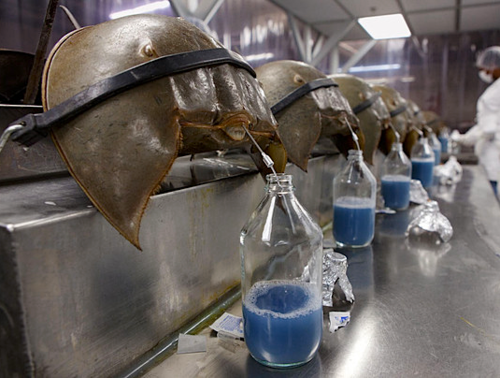It’s a chemical found only in the amoebocytes of its blood cells that can detect mere traces of bacterial presence and trap them in inescapable clots. Horseshoe crabs are an.
Horseshoe Crab Blood Color. So, what makes horseshoe crab blood stand out? But why do horseshoe crabs have blue blood?
 Horseshoe crabs have weird, bright blue blood Grist From grist.org
Horseshoe crabs have weird, bright blue blood Grist From grist.org
It’s unique in more ways than one: And the common horseshoe crab has bright blue blood that gets harvested for bacterial. This compound coagulates or clumps up in the presence of small amounts of bacterial toxins and is used to test for sterility of medical equipment and virtually all injectable drugs.
Horseshoe crabs have weird, bright blue blood Grist
Horseshoe crab blood is a vital resource to the medical field. Known to scientists as coagulogen, the substance keeps unwanted bacteria from spreading. So, what makes horseshoe crab blood stand out? It contains important immune cells that are exceptionally sensitive to toxic bacteria.
 Source: businessinsider.in
Source: businessinsider.in
Horseshoe crab blood is a vital resource to the medical field. It contains important immune cells that are exceptionally sensitive to toxic bacteria. In addition to horseshoe crabs, there are a number of animals (invertebrates*) that have blue blood…crustaceans, such as crab, shrimp, crayfish, lobster, and then snails, slugs and other mollusks, such as clams, mussels, and scallops. Horseshoe crabs.
 Source: awesci.com
Source: awesci.com
The horseshoe crab blood color is bright blue. This is because horseshoe crabs rely on hemocyanin to transport oxygen throughout the body. What color is crabs blood? Known to scientists as coagulogen, the substance keeps unwanted bacteria from spreading. Horseshoe crab blood $60,000 per gallon.
 Source: scienceabc.com
Source: scienceabc.com
But why do horseshoe crabs have blue blood? In humans, this molecule contains iron, while the crab version contains copper, and that affects the color of blood. It’s unique in more ways than one: Horseshoe crab blood contains a special amebocyte that. The blue color and its ability to identify bacterial contamination in small quantities.
 Source: barnorama.com
Source: barnorama.com
And the common horseshoe crab has bright blue blood that gets harvested for bacterial. It contains important immune cells that are exceptionally sensitive to toxic bacteria. The blue color and its ability to identify bacterial contamination in small quantities. All other species on planet earth use iron, as hemoglobin, to capture and transport oxygen in blood. To the medical community,.
 Source: grist.org
Source: grist.org
It’s a chemical found only in the amoebocytes of its blood cells that can detect mere traces of bacterial presence and trap them in inescapable clots. A respiratory pigment binds to oxygen and carries it around the body, keeping organs and tissues oxygenated. The horseshoe crab blood color is bright blue. Horseshoe crab blood contains a special amebocyte that. This.
 Source: reddit.com
Source: reddit.com
However, the horseshoe crab doesn’t use hemoglobin but a different molecule known as hemocyanin. The blood stoskopf drew into his syringe was milky blue, but stoskopf knew that this was not a sign of sickness: In addition to horseshoe crabs, there are a number of animals (invertebrates*) that have blue blood…crustaceans, such as crab, shrimp, crayfish, lobster, and then snails,.
 Source: hight3ch.com
Source: hight3ch.com
In addition to horseshoe crabs, there are a number of animals (invertebrates*) that have blue blood…crustaceans, such as crab, shrimp, crayfish, lobster, and then snails, slugs and other mollusks, such as clams, mussels, and scallops. What’s special about horseshoe crab blood? To learn more, visit the links on the left. Sea squirts have purple blood. They have their own ways.
 Source: blog.nature.org
Source: blog.nature.org
The blue color and its ability to identify bacterial contamination in small quantities. Horseshoe crabs have moving cells inside their blood called amoebocytes. The blood of horseshoe crabs is normally blue. Known to scientists as coagulogen, the substance keeps unwanted bacteria from spreading. But why do horseshoe crabs have blue blood?






